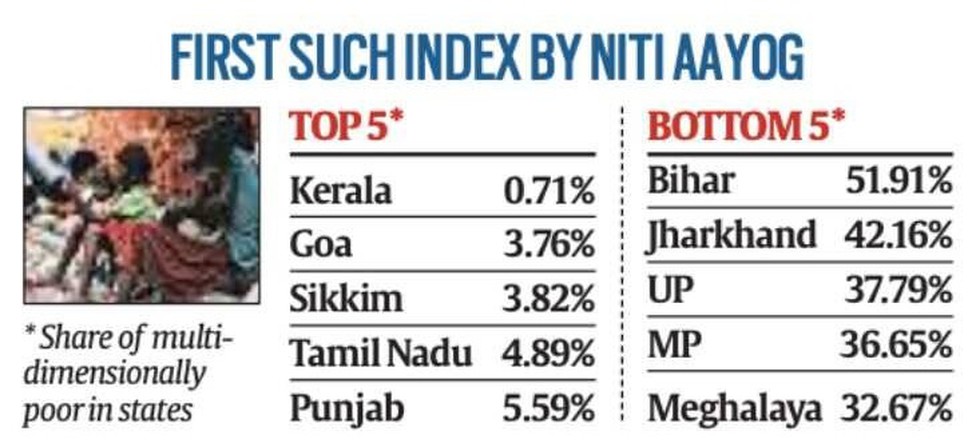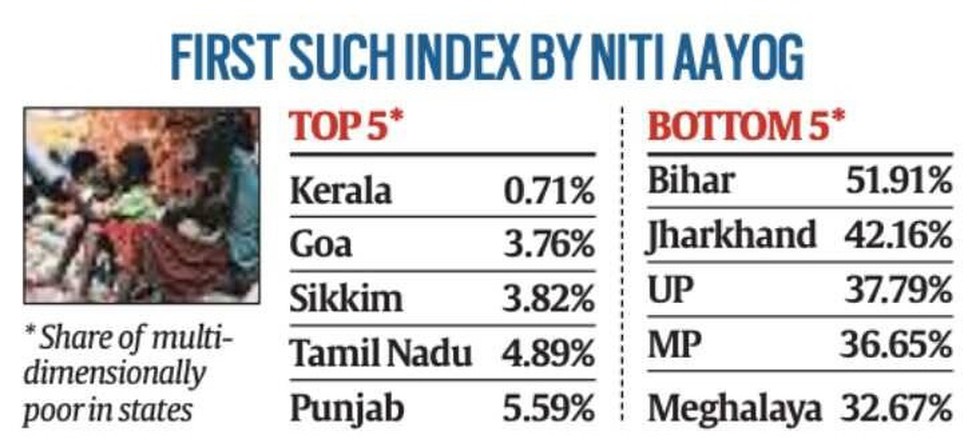CURRENT AFFAIRS
Get the most updated and recent current affair content on Padhaikaro.com
MULTI-DIMENSIONAL POVERTY INDEX (MPI)
- Vaid's ICS, Lucknow
- 11, Apr 2022

Why in News?
The first-ever Multi-dimensional Poverty Index (MPI) prepared by government think tank NITI Aayog has recently said that Bihar has the highest proportion of people, at 51.91 per cent of the state’s population, who are multidimensionally poor, followed by Jharkhand at 42.16 per cent and Uttar Pradesh at 37.79 per cent.

About:
- Bihar also has the highest number of malnourished people followed by Jharkhand, Madhya Pradesh, Uttar Pradesh, and Chhattisgarh.
- Kerala, Goa, and Sikkim have the lowest percentage of population being multidimensionally poor at 0.71 per cent, 3.76 per cent and 3.82 per cent, respectively.
- This baseline report of the national MPI measure is based on the reference period of 2015-16 of the National Family Health Survey (NFHS).
- Among the Union Territories (UTs), Dadra and Nagar Haveli (27.36 per cent), Jammu & Kashmir, and Ladakh (12.58), Daman & Diu (6.82 per cent) and Chandigarh (5.97 per cent), have emerged as the poorest UTs in India.
- The proportion of poor in Puducherry at 1.72 per cent is the lowest among the Union Territories, followed by Lakshadweep at 1.82 per cent, Andaman & Nicobar Islands at 4.30 per cent and Delhi at 4.79 per cent.
Important Info :
Methodology
- The MPI uses the globally accepted methodology developed by the Oxford Poverty and Human Development Initiative (OPHI) and the United Nations Development Programme (UNDP).
- The MPI has three equally weighted dimensions – health, education, and standard of living – which in turn are represented by 12 indicators such as nutrition, school attendance, years of schooling, drinking water, sanitation, housing, bank accounts among others, according to the report.
FACTS FOR PRELIMS:
Omicron:
The World Health Organization (WHO) classified a new variant of SARS-CoV-2, currently circulating in South Africa, as a ‘variant of concern’. It also named it Omicron.
- The Network for Genomics Surveillance in South Africa (NGS-SA) had identified the variant. It had detected a group of related SARS-CoV-2 viruses, which belong to a lineage named B.1.1.529.
- Early indications are that this variant is possibly even more transmissible than the highly infectious Delta variant, and that current vaccines may be less effective against it.
- From what is known currently, B.1.1.529 has multiple spike protein mutations, and preliminary analysis suggests it is highly infectious.
- The has “very unusual constellations of mutations” — with 30 in the region that encodes the spike protein, which is responsible for the virus’s entry in human cells.